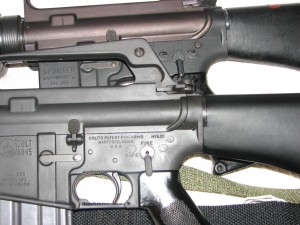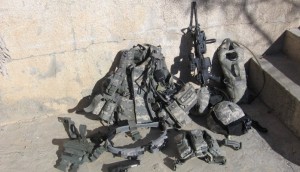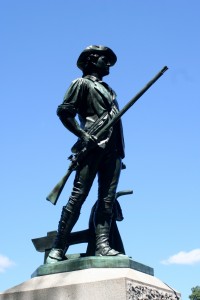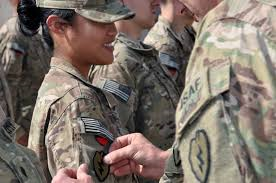 I am an Army veteran with nearly 25 years of service. I spent much of that time as an infantry officer, serving as an infantry platoon leader, as a rifle company commander, as an ROTC instructor, and as the head of a military advisory team embedded with a Kurdish Iraqi Army brigade. I don’t claim to be Sergeant York or Audie Murphy. But I do understand small-unit infantry tactics, and I understand how firearms are employed in combat. I also understand the difference between combat and crime, including mass shootings like those that have plagued us recently. My experience in the infantry tells me that gun control proposals to ban firearms with so-called “military” features are misguided at best, cynical at worst, and accordingly I categorically oppose them. This is why.
I am an Army veteran with nearly 25 years of service. I spent much of that time as an infantry officer, serving as an infantry platoon leader, as a rifle company commander, as an ROTC instructor, and as the head of a military advisory team embedded with a Kurdish Iraqi Army brigade. I don’t claim to be Sergeant York or Audie Murphy. But I do understand small-unit infantry tactics, and I understand how firearms are employed in combat. I also understand the difference between combat and crime, including mass shootings like those that have plagued us recently. My experience in the infantry tells me that gun control proposals to ban firearms with so-called “military” features are misguided at best, cynical at worst, and accordingly I categorically oppose them. This is why.
In his 6 December 2015 speech addressing the terrorist attack in San Bernardino, California, President Obama took the opportunity to float, yet again, a proposal that he has been pushing at least since his reelection campaign against Mitt Romney – a ban on so-called “assault” weapons, which President Obama, and others, characterize as “weapons of war,” and which he characterizes as a “commonsense gun safety” proposal. The President is hardly alone in supporting such a ban. Many other groups do as well, including the Brady Campaign. Given the visual similarity between civilian rifles popular today and their military counterparts, it is not surprising that this proposal would seem reasonable to many who are unfamiliar with firearms and unfamiliar with infantry tactics. But however intuitive it may seem at first glance, the fact is that the President’s proposal is not only not commonsense, it is actually rather arbitrary, and obviously so to anyone who cares to investigate the matter.
Military vs Civilian Firearms
Before going further, it might be useful to point out what makes a gun a military firearm. In modern warfare, the sine qua non of the military battle rifle is selective fire – that is, the ability to fire more than one round with each pull of the trigger. This is the single, essential feature that makes a military firearm more useful in combat than its civilian counterpart. The National Firearms Act calls these weapons “machineguns”, and they have been heavily regulated since 1934, and even more strictly controlled since 1986. The first true “assault rifle” is often said to have been the Wehrmacht’s STG 44, and it is to this rifle that the term itself was first applied – the Germans called the rifle the “Sturmgewehr” which translates roughly to “assault rifle.” Like all battle rifles today, the Sturmgewehr was a select fire weapon. Selective fire has been a standard feature on individual battle rifles in the U.S. military since the U.S. Army began introduction of the M14 rifle in 1959, and in Russia since the introduction of the Kalashnikov family of rifles in 1949. Select fire rifles can be either fully automatic, meaning that on automatic mode the rifle will continue to fire as long as the trigger is depressed (like the M16A1), or burst, meaning that they fire a set number of rounds with each pull of the trigger on burst mode (like the M16A2, which fired a three round burst). The AR15 and AK series rifles popular with civilian shooters today are not select fire weapons.
Whether burst or full auto, selective fire serves one function in combat – to gain fire superiority over an enemy force. Fire superiority is achieved when the enemy has been suppressed – which is to say, when one side is placing such a high volume of fire into the enemy’s general vicinity that the enemy is forced to seek cover and is thereby prevented from returning effective fire (they may still shoot back, but not very well).
Thus, it isn’t necessarily the casualty producing effect that gives fully automatic fire its greatest combat value, but rather its impact on behavior –that is, the effect of impelling the enemy to hide rather than returning well-aimed fire, thus degrading his combat effectiveness.
But selective fire – the single essential element of a military battle rifle today – is not the feature that gun control advocates are talking about when they propose an “assault” weapons ban, as this feature has been effectively (even if not completely) banned since 1986. Instead, they are focusing on other features that are just as useful for sport shooting or other civilian applications as they are in combat shooting. More importantly, as discussed below, the features they want to ban are irrelevant in the context of crime – even mass or spree shootings.
The 1994 Assault Weapons Ban and Senator Feinstein’s 2013 Revival
The purported rationale for banning firearms with military features was succinctly put in a 1999 Justice Department study, where it was stated that weapons with certain features were banned under the 1994 Assault Weapons ban because they “appeared useful in military and criminal applications but that were deemed unnecessary in shooting sports”[1] (emphasis added). In other words, advocates of banning “assault” style weapons proceed on the assumption that any feature useful in combat is also useful in crime, but is not useful sport shooting; also implicit in this quote is the further assumption, that sport shooting is the only legitimate shooting application – which would apparently deem personal self-defense as a non-legitimate application. The phrasing “appeared useful” and “deemed unnecessary” speak volumes, in that it implicitly concedes that the architects of the 1994 assault weapons ban made no effort to verify what they intuitively believed – that civilian firearms resembling military firearms are more dangerous to the public than firearms bearing a more traditional “sporting” configuration.
As a former infantry officer who has a good grasp of small unit tactics and understands how to employ firearms in combat, I can state without hesitation that the assumptions which underpinned the former assault weapons ban and current proposals to revive the same are not valid. Here’s why:
The 1994 Assault Weapons Ban proscribed semi-automatic firearms that could accept a detachable magazine that had two or more of the following features (Senator Feinstein’s 2013 reprise would have narrowed it to one): A folding or telescoping stock; a pistol grip that protrudes beneath the firing action; a bayonet mount; a flash hider or a threaded barrel designed to accommodate one; or a grenade launcher. Senator Feinstein’s 2013 bill added another feature, the barrel shroud (basically, handguards covering the barrel).[2]
Only two of these features are actually strictly military in application: The bayonet mount and the grenade launcher. The risk of any serious crime epidemic involving either of these features is effectively zero. Neither has ever been used in a crime in the United States, at least in modern times, so far as I am aware. In fact, bayonet fighting is so rare even in combat that the U.S. Army discontinued bayonet training in Basic Training in 2010[3], and the last country still extensively using muzzle launched grenades (so far as I am aware) was the former Yugoslavia – and a grenade launcher without the grenades is useless anyway. Thus, of the five enumerated features that were proscribed, the ban on two of them was simply absurd.
The three remaining features – the pistol grip, telescoping or folding stocks, and flash-hiders/barrels threaded to accommodate them (four if you count the barrel shrouds in the 2013 proposal) – are commonly used on contemporary battle rifles, but they are not strictly military features. These are ergonomic improvements over the ancient traditional rifle configuration, each designed to make the weapon more comfortable and convenient for the shooter to use, and therefore more accurate and more pleasant to shoot. These benefits apply to all shooting applications, not just military ones (and, contrary to the assumption, they are in fact used in sporting applications. AR-15 rifles are widely used in match / competition shooting, and for hunting – contrary to popular belief). More important to our discussion, however, is this: While these features do make a firearm more effective in both combat and in sporting applications, they are irrelevant in the vast bulk of criminal scenarios.
The claim above likely seems paradoxical, until one examines the nature of combat, as juxtaposed against the nature of crime. For purposes of this discussion, I define combat, as relevant to a discussion about small arms, this way:
Military combat is a phenomenon wherein a group of armed combatants engage in collective fire and maneuver in a coordinated manner against an opposing armed force that is presumed to be capable of offering meaningful resistance.
The ergonomic features that proponents of an “assault” weapons ban view as “military” in nature are valuable in combat. By making the firearm more comfortable and more convenient to use, they offer the potential to improve the individual Soldier’s marksmanship. Not dramatically, usually, but to a small degree. But in a situation as fiercely competitive as infantry combat, a small advantage enjoyed by a number of Soldiers individually can have enough of an impact cumulatively to influence the outcome of the battle.
“Assault” weapons ban advocates will be quick to argue that this same small advantage enjoyed by a Soldier in combat makes the weapon more dangerous in civilian hands. But this argument is fatally flawed because it is founded upon an invalid assumption: that crime and combat are somehow similar phenomena. They are not. Whereas combat employing small arms involves opposing armed groups, crime, including mass shootings, involves something else altogether:
Violent crime, as it involves small arms, is a phenomenon wherein one or more assailants attack an unprepared victim or group of victims, who are presumed to be unarmed and unable to offer meaningful resistance.[4]
It should be obvious from these definitions that ordinarily a criminal act – including a mass shooting – is entirely different than a small unit combat action. I alluded above to the concept of fire superiority. In dismounted infantry combat, this is achieved by directing a high volume of automatic or burst fire at the enemy’s position. But in a crime, fire superiority is achieved by the mere brandishing of a firearm of any kind. When a criminal wields a firearm he almost always does so against a target or targets he believes to be unarmed. By introducing a firearm into the situation, the criminal tips the balance of power so heavily against the unarmed victims that any marginal advantage garnered through such ergonomic features as pistol grips, adjustable stocks and flash hiders is overwhelmed by and subsumed into the huge disparity of power between the armed assailant and the unarmed victim created by the mere presence of any firearm. In this scenario, one doesn’t even need a semi-automatic firearm to wreak havoc, much less one with supposedly “military” features. A bolt action rifle or revolver would be as effective (this is true even given the factor of reloading, as devices are readily available to facilitate rapid reloading of these types of arms). And remember what I wrote above – that the main value in automatic suppressive fire is in its impact on the enemy’s behavior rather than its casualty producing effect; in a criminal assault, the psychological impact is even more paralyzing, as unarmed victims are usually neither physically nor psychologically capable of doing anything more than hiding or running away, which in turn may further expose them to the criminal’s fire.
Given the irrelevance in crime of the ergonomic features some seek to ban, as demonstrated above, firearms bans based upon these features are simply arbitrary and capricious. However, advocates of “assault” weapons bans would point to another feature – detachable, “high capacity” magazines.[5] Intuitively this would seem to be the gun control advocate’s strongest point of attack. But the fact is that a shooter can change magazines very quickly – faster than most people can respond. And, as with the ergonomic features described above, magazines with a capacity of more than 10 rounds (or 5, or whatever number is selected) have legitimate uses in civilian shooting applications.
Given these factors, even those few crimes actually committed with so-called “assault” weapons could just as easily have been executed with other weapons, such as semi-automatic pistols. Maybe even more effectively in some instances, given that pistols can be more easily concealed and that the smaller size and weight of both their ammunition and magazines would allow a killer to carry more rounds.
Conclusion:
I believe in liberty. If you come to me with a proposal that would curtail my liberty – or that of anyone else – in any respect, it had better be soundly reasoned and the benefit must demonstrably outweigh the cost. Sensationalized spree shootings notwithstanding, only a tiny fraction of all homicides are committed with rifles of any kind – and so-called “assault” weapons are only one type of rifle. In 2011, of the 12,644 homicides and 6,996 gun homicides for which the gun type is specified, as reported by the FBI[6], only 323 were recorded as having been committed with rifles – 4.5% of the total for which the type of firearm was specified. The FBI statistics include a category of “Firearm, type not stated.” Assuming that the proportion of these homicides involving rifles is the same as the proportion where the type of firearm is known would give us a total of 395 homicides using rifles – about 4.6% of total firearms homicides and about 3% of all homicides total. According to the same statistics, the number of homicides involving rifles is less than the number of people killed by beatings with hands and fists (728), blunt objects (496), or knives/cutting instruments (1,694). And it will not do to argue that at least banning so-called “assault” rifles would have prevented the 3% of murders attributed to them: first, because the 3% figure includes all rifles of every type and not just rifles that resemble military weapons, and second because it is obvious that many, most, or even all of those who used rifles to murder would just have resorted to another firearm had the rifle not been available. In summary, the ban on so-called “assault” weapons would have no discernable impact on crime, high-profile mass-killings notwithstanding (which, after all, could just as well easily have been perpetrated with other types of guns or, in the case of the San Bernardino terror attack, with explosives). Given the absence of any discernable impact on crime, curtailing my liberty by denying me access to a popular type of firearm that I deem useful for lawful purposes is not warranted and not something I am not prepared to tolerate.
[1] Roth, Jeffrey A. and Christopher S. Koper, Impacts of the 1994 Assault Weapons Ban: 1994–96, National Institute of Justice Research Brief, March 1999.
[2] See http://www.feinstein.senate.gov/public/index.cfm/assault-weapons-ban-summary
[3] “One less skill for soldiers to master at boot camp: bayonet training”, Christian Science Monitor online, 10 September 2010; http://www.csmonitor.com/USA/Military/2010/0928/One-less-skill-for-soldiers-to-master-at-boot-camp-bayonet-training
[4] Obviously, there are exceptions, as where criminals shoot police officers. But as with other gun crime, these attacks are rarely carried out with so-called “assault” rifles, sensational exceptions notwithstanding, and most are ambushes wherein the officer is attacked by surprise and where the type of firearm is not particularly relevant, because it is the element of surprise, not the ergonomic features of the arm, upon which the criminal relies. We may take it as a given that if the engagement with police lasts more than a few seconds or minutes at most, the assailant will be overwhelmed and subdued in due course.
[5] Of course, what constitutes “high capacity” is subject to debate. The AR-15 as originally offered to the public for sale as a sporting weapon in 1964 came with a 20 round magazine – much more than the limit gun control advocates view as “high capacity.”
[6] See https://www.fbi.gov/about-us/cjis/ucr/crime-in-the-u.s/2011/crime-in-the-u.s.-2011/tables/expanded-homicide-data-table-8
 In the minds of most, military justice is synonymous with a Court Martial. If they think about military justice at all, they probably envision something out of Hollywood – Lieutenant Kaffee thundering away at Colonel Jessup in A Few Good Men, or Lieutenant Greenwald eviscerating Captain Queeg on the stand in The Caine Mutiny. But only a tiny fraction of the allegations made against Service members are resolved at trial by Court Martial. In the vast majority of cases, accusations against a service member are both investigated and adjudicated administratively. And while the military characterizes administrative sanctions as not “punitive”, the fact is that they can have a ruinous impact both on your career and on your life afterward. If you find yourself the subject of any kind investigation or corrective action, it is imperative that you take it seriously and mount a vigorous defense from the beginning.
In the minds of most, military justice is synonymous with a Court Martial. If they think about military justice at all, they probably envision something out of Hollywood – Lieutenant Kaffee thundering away at Colonel Jessup in A Few Good Men, or Lieutenant Greenwald eviscerating Captain Queeg on the stand in The Caine Mutiny. But only a tiny fraction of the allegations made against Service members are resolved at trial by Court Martial. In the vast majority of cases, accusations against a service member are both investigated and adjudicated administratively. And while the military characterizes administrative sanctions as not “punitive”, the fact is that they can have a ruinous impact both on your career and on your life afterward. If you find yourself the subject of any kind investigation or corrective action, it is imperative that you take it seriously and mount a vigorous defense from the beginning.


